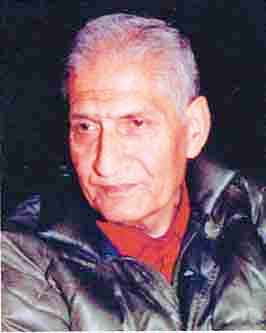Jang S. Verman
To pay tribute to a humble person like Sh. Suraj Saraf is a tough job. To do the same may look contrary to his ideals. Born on 24th June, 1924 in the family of Sh. Mulak Raj Saraf, a veteran journalist and founder of journalism in the state of J&K, Sh. Suraj Saraf is known for his humble and kind nature with high intellectual thinking. He has been an extraordinary, cool and devotional person, who could not be understood without spending a good span of time with him. At the first look, he appeared to be a very simple person with soft and trivial vocabulary, but by spending time with him, one could find that he spoke with proper weight on his words and ideas.
As I have seen him, he was not only an intellectual par excellence, but inherited the skills of journalism from his father Sh. Mulak Raj Saraf. After completing his B Sc.; LLB, Sh. Suraj Saraf started his career as correspondent with Times of India, Hindu and The Tribune. After 1977 he represented several local and national dailies till he breathed his last.
Not only did he work as journalist for reporting in local and national dailies, but had an aptitude also to write on various aspects of art, culture, archeology, tourism and heritage of the region, extensively. He was not only a journalist but photographer, writer and a chronicle recorder of his times. He has penned down about the life and works of the artists, writers and other such personalities like Master Sansar Chand Baru (Painter), Vidya Rattan Khajuria (Sculptor), Vijay Gupta (Painter), Vachaspati Sharma (Sitarist), K L Verma (Tabla Meastro), T K Jalali (Violinist), N D Jamwal (Writer & Artist), Devi Dass (Portrait Expert), Prof. Lalit Magotra,(Writer and Scientist), Padamshree (Prof.) Ram Nath Shastri (Literature), Padamshree Balwant Thakur (Theatre), Padamshree Rajinder Tiku (Sculptor), Prof. Champa Sharma (Writer), Gobind Kaur (Sculptor), Vijay Saraaf Meenaghe (Painter), Jang S. Verman (Multi-Media Artist), Ravinder Jamwal (Sculptor), Deepak Kumar (Theatre) and so on.
He had put a lot to investigate the facts related to the culture and other historical data about the region which is evident from the script of his book-‘Jammu Heritage’. Hinting on the traces of antiquity of Jammu, he argues ‘….setting up of the fort, facing Jammu on the other side of river Tawi is also inscribed by Vanasabali to Bahu Lochan, elder brother of Jambo Lochan, which must have been before Mahabharata as Jambu, …. The fort still stands imposingly, though obviously it must have been repaired, renovated and undergone changes several times. It is also significant that Bahu fort is also mentioned in about 1st century A. D. at the times of invasions from Sialkot and Kanauj. Later it was also mentioned in late fourteenth century at the time of Timur’s invasion’.
He also wrote books on art, craft, archeology, tourism, faith and heritage with great details and research. These books have been among his fine contribution in the field of documentation of the ideas and ideals behind faith, creativity and varied approaches of development in the field of crafts in the region. Among other publications of his books the followings are the outstanding contributions by him. These books are entitled as – ‘Jammu Glimpses’, ‘Babor’, ‘Jammu Darshan’, ‘Jammu Heritage’ and ‘Vaishno Devi’.
As he was interested in documentation of the art & craft, culture, places of tourist interest and mythological value in the expression of people, he had strong desire for photographing these elements through camera, along with use of letters. He has done photography at stretch to record values behind the faith and cult of society around. At the same time he used his eye for capturing scenes around which he would depict his aesthetical sensitivity to such scenes. This way he could document art, craft and the visuals related to the places of tourism and archeological importance. This form of art has been able to provide basic details and pictorial view of different aspects of art and craft in the right perspective as seen by a journalist, writer and a visualizer. His photographs were well received by the writers and publishers, and subsequently included in the book ‘Arts & Crafts of Jammu & Kashmir’ written by Sh. D N Saraf.
His work and contribution has always been acknowledged. He was honoured with ‘Dogra Rattan’ by Dogri Sanstha, Jammu. His photography was declared first by Illustrated Weekly of India during the year 1972. ‘Neo- Images’- a group of photographers established in Jammu also honoured him during 1992 for his contribution in the field of photography.
In his message, published in his book titled-‘Jammu Darshan”, Jenab G M Sadiq, the then Chief Minister, J&K Government, wrote: ‘Guide to Jammu was a much needed Publication. That this venture is being undertaken by our veteran journalist Shri Suraj Saraf and the guide is being compiled by a journalist of the standing of Shri Suraj Saraf is a matter of all the more satisfaction to me…..’
Whereas his contribution to highlight cultural heritage of Jammu region at local and national level deserves appreciation and commendation, to remember such saintly and devoted person, by organizing befitting events in his memory, will be a real return for his honour and a true tribute to a pious soul.


